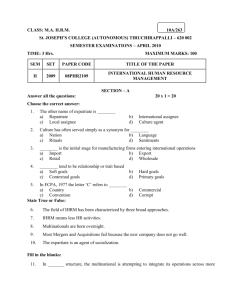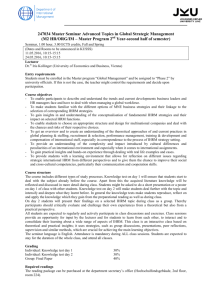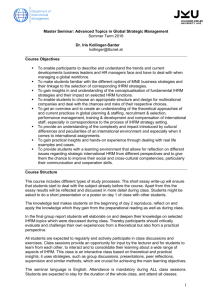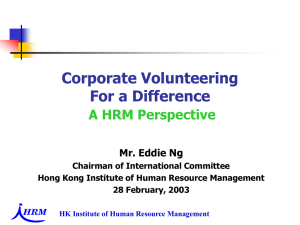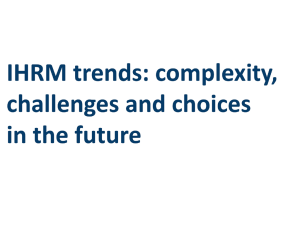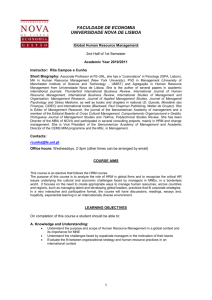Chapter 2
advertisement
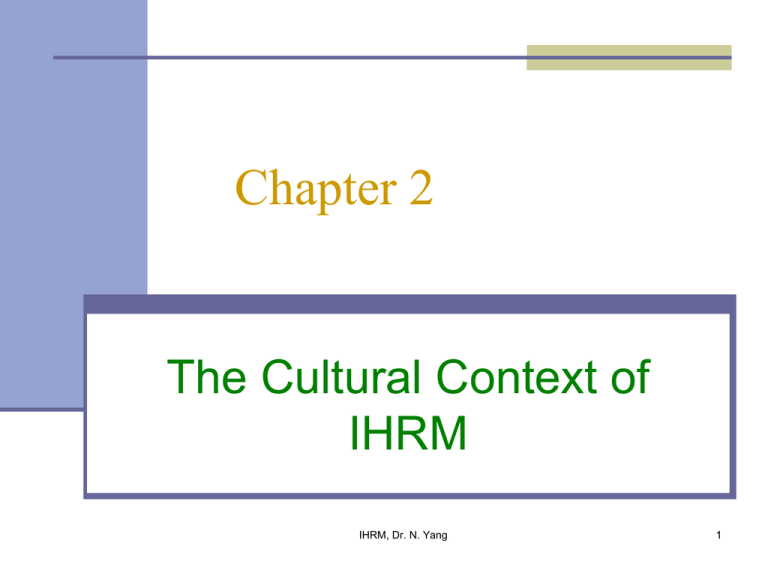
Chapter 2 The Cultural Context of IHRM IHRM, Dr. N. Yang 1 Chapter Objectives Review key issues and implications: Definitions of culture Cultural concepts Results of various intercultural management studies, such as Kluckhohn & Kroeber, Schein, Hofstede, GLOBE, Trompenaars & Hampdenturner, Hall & Hall, and several others Reflections on cross-cultural management research Discussions on development of cultures IHRM, Dr. N. Yang 2 Definitions of Culture Culture consists in patterned ways of thinking, feeling, and reacting, acquired and transmitted mainly by symbols, constituting the distinctive achievements of human groups … including their embodiments in artefacts; the essential core of culture consists of traditional ideas and especially their attached values (Kluckhohn & Kroeber, 1950s) Mental programming, a system of shared values and social norms, or “software of the mind” (Hofstede, 1991) Culture normally relates to nations but a nation-state explanation is of ongoing debates and criticism. IHRM, Dr. N. Yang 3 Kluckhohn & Kroeber Culture consists in patterned ways of Thinking Feeling Reacting acquired & transmitted mainly by symbols, constituting the distinctive achievements of human groups, including their embodiments in artefacts The essential core of culture consists of IHRM, Dr. N. Yang traditional ideas & their attached values 4 Basic Elements of Culture Hansen’s description of cultures as the customs of a community practiced by a majority Standardization may come up in specific situations Standardization of communication Standardization of thought Standardization of feeling Standardization of behavior IHRM, Dr. N. Yang 5 Levels of Culture Schien’s concept of culture in the course of organizational research Artefacts – visible Values – intermediate level of consciousness Underlying assumptions – invisible, unconscious IHRM, Dr. N. Yang 6 Underlying Assumptions Nature of reality & truth Time dimension Effect of spatial proximity & distance Nature of being human Type of human activity Nature of human relationships IHRM, Dr. N. Yang 7 Cross-cultural Management Studies Describe and compare the working behavior in various cultures Explain and improve interaction between employees, customers, suppliers or businesses in different countries & cultures IHRM, Dr. N. Yang 8 Hofstede’s Five Cultural Dimensions Power distance Uncertainty avoidance Femininity vs. masculinity Individualism vs. collectivism Confucianism or long-term orientation IHRM, Dr. N. Yang 9 Confucianism Dynamics Long-term Orientation Short-term Orientation Great endurance, persistence in Personal candor & stability pursuing goals Avoiding loss of face Position of ranking based on status Respect of social & status Adaptation of traditions to modern conditions Respect of social & status obligations within limits High savings rates & high investment activity Readiness to subordinate oneself to a purpose obligations without consideration of costs Low savings rates & low investment activity Expectations of quick profit Respect for traditions Greetings, presents & courtesies based on reciprocity The feeling of shame IHRM, Dr. N. Yang 10 Figure 2.1 Results of Hofstede’s Study: Power distance & individualism vs. collectivism IHRM, Dr. N. Yang 11 Table 2.1 Impact of the Cultural Context on HRM Practices IHRM, Dr. N. Yang 12 HRM in Action Case 2.2 Long-term Development Plans of a German MNE in the USA A German MNE in the electrical industry expanded to the U.S., taking a polycentric HRM approach to recruit and promote local managers; Invested in training and dev. for fast-track career opportunities; CEO Peter Hansen was happy with the firm performance, growth, and progress achieved However, he was shocked by turnovers, including John Miller, Marketing Director, after high-level training programs from top business schools sponsored by the firim. IHRM, Dr. N. Yang Can you explain CEO Hansen’s surprise using Hofstede’s cultural dimensions? How does this situation compare to situations in your home country or countries you are familiar with? What are the limits of a cultural explanation? 13 Reflections of Hofstede’s Study The Western team and influence on the form of the questionnaire Countries rather than cultures are delimited some surveyed states do not exist today, like the former Yugoslavia Realization of intra-level studies along with assessing the individual, groups, organizations, and country levels Inclusion of cross-cultural differences Consider intra-cultural variance Inclusion of theoretically relevant moderators Consider variables like sex, class affiliation, etc. Effects of interaction between cultural variables IHRM, Dr. N. Yang 14 Questions by the GLOBE Study Are there leadership behaviors, attributes and organizational practices that are generally accepted and effective across cultures? Are there leadership behaviors, attributes and organizational practices that are accepted and effective in some cultures only? How much do leadership attributes affect the effectiveness of specific leadership behavior and its acceptance by subordinates? How much do behaviors and attributes in specific cultures influence the economic, physical, and psychological well-being of members in the researched societies? What is the relationship between these socio-cultural variables and an international competitive capacity of the various sample societies? IHRM, Dr. N. Yang 15 Eight Cultural Dimensions of the GLOBE Study Institutional collectivism In-group collectivism Uncertainty avoidance Power distance Gender egalitarianism Assertiveness Performance orientation Humane orientation IHRM, Dr. N. Yang 16 Reflections of the GLOBE Attempted to avoid a one-sided Western focus More industries, broader profiles, and levels of analysis (e.g., individual, organizational, societal) were taken into consideration Criticized for further differentiation of cultural dimensions by Hofstede Data representation of cultures with large and heterogeneous populations, such as China, India, the USA IHRM, Dr. N. Yang 17 Trompenaars & Hampden-Turner’s Seven Dimensions of Culture Relationships Between people 1. 2. 3. 4. 5. Universalism vs. particularism Individualism vs. communitarianism Emotional vs. neutral Specific vs. diffuse Ascription vs. achievement Concept of time 6. Sequential vs. synchronic concept of time Concept of nature 7. Internal vs. external control IHRM, Dr. N. Yang 18 HRM in Action Case 2.2 Meeting on a Friday in Kenya A MNE has completed its project in Kenya but has not been paid A meeting with the representative of the local government agency was arranged on Friday at 10 a.m. The representative was polite and friendly, but the meeting was frequently interrupted by his phone calls and conversations in local language regarding his family event over the coming weekend Both parties got extremely tense and finally had to schedule a new meeting for the following Tuesday How can you explain this frustration with some cultural dimensions, such as the Trompenaars’? How does this situation compare to your home country or countries you are familiar? IHRM, Dr. N. Yang 19 Cultural Dimensions by Hall & Hall High vs. low context communication Indirect vs. direct, implicit vs. explicit, verbal vs. nonverbal expressions Spatial orientation Actual distance between people when communicating Monochrome vs. polychrome concept of time Sequential processes vs. parallel actions Information speed High or low information flow during communication IHRM, Dr. N. Yang 20 The Development of Cultures Convergence or divergence Transnational regions Growing interdependence Intra-cultural changes Value shift between generations IHRM, Dr. N. Yang 21 Static-dynamic Nature of Culture There is increasing International connectedness Global economy coordination Harmonization of laws & regulations High flow of migration Cultures are not confined to given territories. This means new challenges for HRM. How resistant are cultures to change? Generation Y are fast, self-organized & absorbed learners with distinct work-life balance preferences Aging of entire societies and the workforces Transferability of HR policies across cultures IHRM, Dr. N. Yang 22 Chapter Summary Definitions of culture Introduction to cross-cultural management research, concepts, critiques, and debates Schein’s concept of culture Hofstede’s study The GLOBE Trompenaars & Hampden-Turner’s study Hall & Hall’s cultural dimensions The development of cultures Implications to HRM and IHRM IHRM, Dr. N. Yang 23 Vocabulary Culture as defined by Kluckhohn & Kroeber, Hofstede, and Hansen Schein: Trompenaars & Hampden-Turner: Universalism vs. particularism, individualism vs. communitarianism, neutral vs. emotional, diffuse vs. specific, ascriptive vs. achievement, sequential vs. synchronic time, internal vs. external control Hall & Hall: High vs. low context, spatial orientation, polychrome vs. monochrome time, information speed Static-dynamic nature of culture Organizational culture, national culture Inter- and intra-cultural variables, Convergence and divergence of HRM and practices Artefacts, values, underlying assumptions Cross-cultural management Hofstede: Power distance, uncertainty avoidance, femininity vs. masculinity, individualism vs. collectivism, long-term orientation, Confucianism dynamics GLOBE: In-group collectivism, institutional collectivism, uncertainty avoidance, power distance, gender egalitarianism, assertiveness, performance orientation, humane orientation IHRM, Dr. N. Yang 24 Discussion Questions 1. Define culture. How can culture be conceptualized? 2. Outline and discuss cross-cultural management studies by Hofstede. 3. Outline and discuss the concepts and results of the GLOBE study. 4. Outline and discuss the cultural dimensions by Trampenaars et al. 5. Compare high vs. low context communication patterns 6. What do you think about the statement “cultures in Europe are becoming more similar”? IHRM, Dr. N. Yang 25
